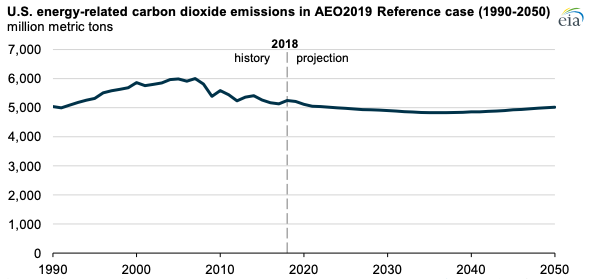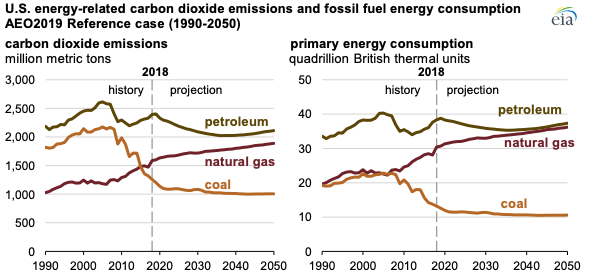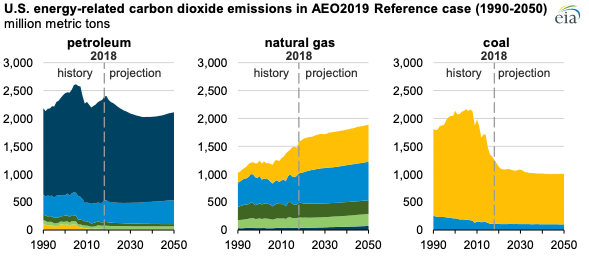Carbon dioxide emissions from U.S. energy consumption will remain near current levels through 2050, according to projections in EIA’s Annual Energy Outlook 2019. The AEO2019 Reference case, which reflects no changes to current laws and regulations and extends current trends in technology, projects that U.S. energy-related carbon dioxide (CO2) emissions will be 5,019 million metric tons in 2050, or 4% below their 2018 value, as emissions associated with coal and petroleum consumption fall and emissions from natural gas consumption rise.

Energy-related CO2 emissions generally follow energy consumption trends. In the United States, emissions associated with the consumption of petroleum fuels—motor gasoline, distillate, jet fuel, and more—have consistently made up the largest portion of CO2 emissions. In 2018, the transportation sector’s consumption accounted for 78% of U.S. CO2 emissions from petroleum and more than one-third of all U.S. energy-related CO2 emissions. Petroleum emissions from other sectors have fallen in recent years as equipment and processes that use petroleum fuels have been replaced by those using other fuels, in particular, natural gas.

In the transportation sector, consumption and emissions trends in the past have been driven by changes in travel demand, fuel prices, and fuel economy regulations. In EIA’s AEO2019 Reference case projection, current fuel economy standards stop requiring additional efficiency improvements in 2025 for light-duty vehicles and in 2027 for heavy-duty vehicles, reflecting existing regulations. As travel demand continues to rise, transportation consumption and emissions increase.
Natural gas is the least carbon-intensive fossil fuel, and for decades natural gas made up the smallest portion of U.S. energy-related CO2 emissions. However, in 2015, natural gas emissions surpassed coal emissions, and the AEO2019 Reference case projects that natural gas CO2 emissions will continue increasing as natural gas use increases. The U.S. electric power sector—now the largest consuming sector for natural gas—has added generating capacity from natural gas in recent years and has used those power plants more often. Natural gas surpassed coal to become the most prevalent fuel used to generate electricity in the United States in 2016.

Other sectors have also increased their consumption of natural gas. By the mid-2020s, EIA projects that the industrial sector will again become the largest consumer of natural gas, using natural gas as a feedstock in chemical industries, as lease and plant fuel, for industrial heat and power applications, and for liquefied natural gas production. The residential and commercial sectors are also expected to continue using more natural gas. For instance, EIA projects that natural gas furnaces will be used in 55% of U.S. homes in 2050, an increase from their 49% share in 2018.
Coal CO2 emissions in the United States are almost all from the electric power sector. Only about 10% of coal CO2 emissions came from the industrial sector in 2018, and this percentage is expected to remain the same through 2050. Although the AEO2019 Reference case projects that nearly one-third of the existing coal-fired electricity generating capacity retires within the next decade, the surviving fleet is used more often, meaning coal’s projected decline in electricity generation is less than the capacity retirements would suggest.
Principal contributor: Owen Comstock

Follow us on social media: